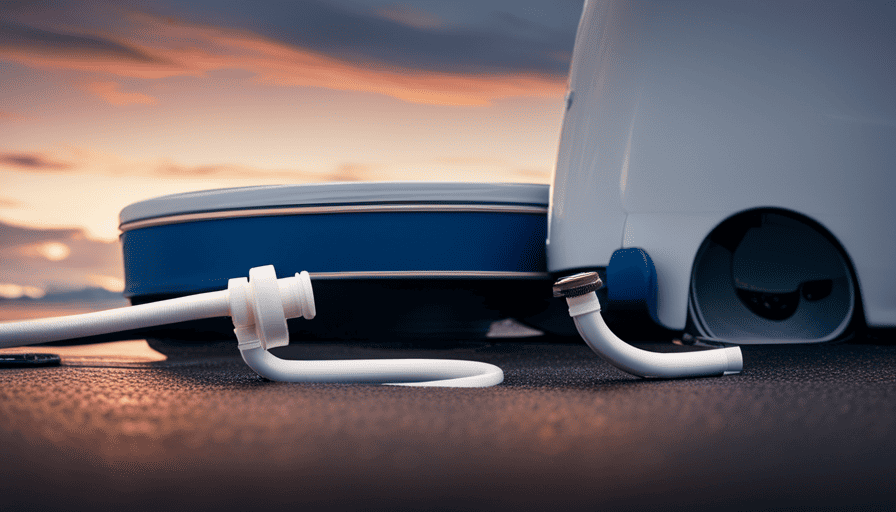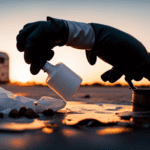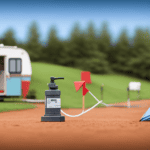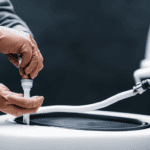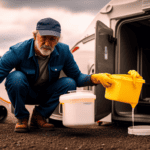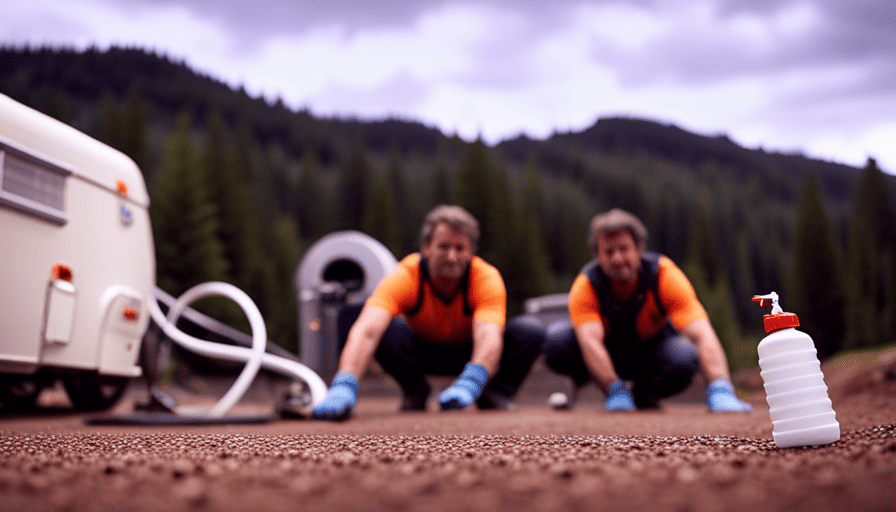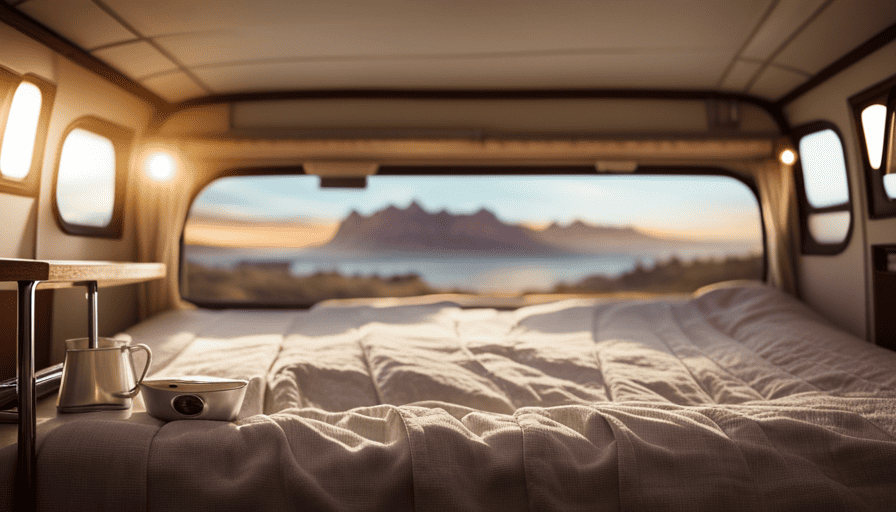Emptying camper sewage might not be the most delightful aspect of camping, yet it is a crucial step in ensuring a sanitary and enjoyable camping journey. Throughout this enlightening piece, I will walk you through the thorough process of effectively draining your camper’s sewage.
From gathering the necessary equipment to disposing of waste responsibly, I’ve got you covered. With a little know-how and the right tools, you can ensure that your camper’s sewage system is functioning effectively and efficiently. So, let’s dive into this detailed guide and learn how to empty your tanks with ease.
Get ready to embark on a journey towards a clean and hassle-free camping adventure!
Key Takeaways
- Finding a designated dumping station is crucial for proper waste disposal.
- Connecting the sewage hose securely and tightly is important to prevent leaks or spills.
- Emptying the tanks should be done in the proper order: black water tank valve first, then gray water tank valve.
- Proper storage and maintenance of the sewage hose is necessary to prevent contamination and odors.
Gather the necessary equipment
Now let’s gather all the equipment you’ll need to drain your camper’s sewage. Equipment maintenance is crucial for a smooth and hassle-free process.
First, make sure you have a pair of heavy-duty rubber gloves to protect your hands from any potential contact with waste. Additionally, a sewer hose is essential for connecting your camper’s sewage outlet to the dumping station. It’s important to regularly inspect the sewer hose for any signs of wear and tear, such as cracks or leaks, and replace it if necessary. To secure the hose and prevent any spills or leaks, a sturdy, tight-fitting hose clamp is recommended.
Another crucial tool is a clear sewer hose adapter that allows you to monitor the flow and ensure proper drainage. Lastly, keep a bucket and some disinfectant wipes handy for cleaning up any accidental spills or messes. Remember to always follow safety precautions when handling sewage, such as wearing appropriate protective gear and washing your hands thoroughly afterwards.
With all the necessary equipment in hand, let’s move on to finding a designated dumping station to safely dispose of your camper’s sewage.
Find a designated dumping station
To properly dispose of waste from your camper, it’s essential to locate a designated dumping station nearby. Finding a dumping station location is crucial for proper waste disposal and maintaining a clean environment.
These stations are specifically designed to handle and dispose of camper sewage in a safe and sanitary manner. When searching for a dumping station, you can start by checking online directories or using smartphone apps that provide information on the nearest stations.
It’s important to ensure that the station you choose is suitable for your camper’s waste disposal needs. Some stations may only accommodate certain types of waste or have specific regulations, so it’s crucial to read the guidelines beforehand.
Once you have found a suitable dumping station, plan your route accordingly. Consider factors such as distance, accessibility, and operating hours. It’s advisable to call ahead and confirm the station’s availability to avoid any inconvenience.
Locating a designated dumping station is the first step towards proper waste disposal for your camper. By finding the right station and planning your visit, you can ensure a smooth and hassle-free experience.
Now, let’s move on to preparing the camper for waste disposal.
Prepare the camper
Get your camper ready by making sure everything’s clean and organized, so you can enjoy a worry-free waste disposal experience.
To prepare your camper for sewage draining, it’s important to have a checklist handy. Firstly, gather all the necessary tools such as gloves, a sewer hose, a sewer hose support, and a sewer hose adapter.
Inspect your camper’s sewage system and make sure there aren’t any leaks or damages. Clean the black and gray water tanks thoroughly to prevent any unpleasant odors. It’s also recommended to add a tank treatment solution to maintain the sewage system’s efficiency.
Next, make sure the valves are functioning properly and not stuck. Lubricate them if necessary. Double-check that all the connections are tight to prevent any leakage during the draining process. Additionally, make sure you have enough water in the black tank to facilitate a smooth flow.
By following these tips for maintaining your camper sewage system, you can avoid any potential issues during the waste disposal process.
Now, with your camper fully prepared, it’s time to connect the sewage hose and begin the draining process smoothly.
Connect the sewage hose
To connect the sewage hose, I first attach one end to the camper’s waste outlet. This ensures that the waste from the camper will flow into the hose.
Next, I connect the other end of the hose to the dump station’s sewer inlet. This allows the waste to be properly disposed of.
Lastly, I make sure to create a secure and tight connection between the hose and both the camper and the dump station. This prevents any leaks or spills during the draining process.
Attach one end to the camper’s waste outlet
First, connect one end of the hose to the camper’s waste outlet to ensure a secure and leak-free connection. To attach the hose, locate the waste outlet on the side or underneath the camper. Remove the protective cap and inspect the outlet for any debris or obstructions.
Take the end of the hose and slide it onto the waste outlet, making sure it fits snugly. Twist the hose clockwise until it locks into place. This will create a tight seal and prevent any leaks during the draining process.
Once the hose is securely attached, you’re ready to move on to the next step of the process: attaching the other end to the dump station’s sewer inlet.
Attach the other end to the dump station’s sewer inlet
Once the hose is securely attached to the camper’s waste outlet, you can easily connect the other end to the dump station’s sewer inlet. This will ensure a seamless flow for all your wastewater needs. When choosing a dump station location, it’s important to consider accessibility and proximity to your camping site. Look for designated dump stations in campgrounds or RV parks, as they’re equipped with proper waste disposal facilities.
Before connecting the hose, make sure the dump station’s sewer inlet is clean and free of any debris. Align the hose with the inlet and firmly push it in until you hear a click or feel a secure connection. This will prevent any leaks or spills during the draining process.
Now, let’s move on to the next section and learn how to ensure a secure and tight connection with the dump station.
Ensure a secure and tight connection
Make sure that you firmly attach the hose to the dump station’s sewer inlet to ensure a secure and tight connection, guaranteeing a seamless flow of wastewater. Ensuring a proper connection is essential to prevent leaks and avoid any messy situations. To achieve this, follow these steps:
- Position the hose clamp over the connection point.
- Slide the hose onto the sewer inlet, ensuring a snug fit.
- Tighten the hose clamp with a screwdriver or wrench to secure it in place.
By tightly connecting the hose to the dump station’s sewer inlet, you prevent any wastewater from leaking out and causing a potential hazard. Once the connection is secure, you can proceed to the next step of emptying the tanks without worrying about any leaks or spills.
Empty the tanks
To start, you’ll want to gather your gloves and a sewer hose before getting ready to empty the tanks. Make sure you have all the necessary cleaning supplies handy to ensure a thorough job.
Here are five important things to keep in mind while emptying the tanks:
-
Securely attach the sewer hose to the RV’s waste outlet to avoid any leaks or spills. This will help maintain a clean and odor-free environment.
-
Open the black water tank valve first, allowing the sewage to drain out completely. Be patient and let gravity do its work. Avoid any sudden movements that could cause splashing or accidents.
-
Once the black water tank is empty, open the gray water tank valve. This will flush out any remaining waste and help clean the sewer hose.
-
Use odor-control products, such as RV-specific deodorizers or holding tank treatments, to minimize unpleasant smells. These products can also help break down solids and prevent clogs.
-
After emptying the tanks, thoroughly rinse the sewer hose with fresh water. This will help remove any remaining waste and prevent lingering odors.
Now that the tanks are empty, it’s time to move on to the next step – rinsing and cleaning the tanks.
Rinse and clean the tanks
Now that the tanks are empty, it’s time to give them a thorough rinse and scrub to ensure they’re squeaky clean. Cleaning your camper sewage tanks is a crucial part of the maintenance routine to prevent unpleasant odors and keep the system working efficiently.
To start the cleaning procedure, connect a hose to a dedicated tank rinsing inlet, usually located on the outside of the camper. Turn on the water supply and let it run for several minutes until the water coming out of the discharge hose runs clear. This will help remove any remaining waste and debris from the tanks.
Next, use a tank cleaning wand or a tank cleaning solution specifically designed for RV sewage systems. Insert the wand or pour the solution into the toilet, following the manufacturer’s instructions, and thoroughly scrub the inside of the tanks. This will help remove any residual waste and eliminate bacteria and odors.
After rinsing and cleaning the tanks, it’s important to disconnect and store the sewage hose properly to prevent contamination and damage. Simply remove the hose from the sewage outlet, making sure it’s fully drained, and carefully coil it up for storage.
With the tanks rinsed, cleaned, and the sewage hose safely stored, your camper sewage system is now ready for the next adventure.
Disconnect and store the sewage hose
To properly disconnect and store the sewage hose, it’s important to follow a few key steps.
First, rinse the hose thoroughly with clean water to ensure all waste is removed.
Next, carefully remove the hose from the waste outlet and sewer inlet, taking care to avoid any spills or splashes.
Finally, store the hose in a designated container or compartment to keep it clean and organized for future use.
It’s essential to properly maintain and store the sewage hose to ensure it remains in good condition and to prevent any contamination or odors.
Rinse the hose thoroughly with clean water
First, make sure you rinse the hose thoroughly with clean water to ensure proper sanitation. This step is crucial in the cleaning process and essential for hose maintenance.
By rinsing the hose with clean water, you remove any leftover waste or residue, preventing unpleasant odors and potential contamination. Start by attaching a spray nozzle to a water hose and turn on the water. Insert the nozzle into one end of the hose and spray water through it. Move the nozzle back and forth, ensuring all areas of the hose are thoroughly rinsed. Pay close attention to the interior of the hose, as this is where most buildup occurs.
Once the hose is clean, you can remove it from the waste outlet and sewer inlet, preparing for the next step.
Remove it from the waste outlet and sewer inlet
After thoroughly rinsing the hose, it’s time to disconnect it from the waste outlet and sewer inlet.
Prepare your equipment by wearing gloves and having a bucket or towel nearby to catch any excess sewage.
To disconnect, first, locate the locking mechanisms on both the waste outlet and sewer inlet. These may vary depending on your camper model, but commonly involve twisting or pulling to release the hose.
Once unlocked, gently pull the hose away from both connections, making sure to avoid any spills or leaks. Remember to secure the connection on the waste outlet to prevent any contamination.
Now, with the hose disconnected, you can move on to the next step: store it in a designated container or compartment. This will protect the hose from damage and keep it clean for future use.
Store it in a designated container or compartment
Now that we’ve successfully removed the sewage from the waste outlet and sewer inlet, the next step is to store it in a designated container or compartment.
This is an important process to ensure proper waste disposal and prevent any leaks or spills. There are various sewage storage options available, such as portable holding tanks or built-in storage compartments in your camper. These containers are specifically designed to safely hold and contain the sewage until it can be disposed of properly.
It’s crucial to follow the manufacturer’s instructions on how to properly use and maintain these storage containers.
Once the sewage is securely stored, we can then move on to the next step, which is to dispose of the waste properly.
Dispose of waste properly
When it comes to disposing of waste in my camper, I always make sure to follow the local regulations for waste disposal. This means using designated dump stations or sewage treatment facilities, which are specifically designed to handle and treat camper sewage.
It is crucial to never dump waste in unauthorized areas, as this can contaminate the environment and pose health risks.
Follow local regulations for waste disposal
It’s important to abide by local regulations for waste disposal when draining camper sewage. Waste disposal regulations and guidelines vary from place to place, so it’s crucial to familiarize yourself with the specific requirements of the area you are in. Here are some key points to keep in mind:
- Check with the local authorities or campground management to understand the specific waste disposal regulations in the area.
- Follow any restrictions on the types of waste that can be disposed of and the methods of disposal.
Ensure that you are aware of any designated dump stations or sewage treatment facilities available for use in the area.
By following these waste disposal regulations and guidelines, you can ensure that you are responsibly disposing of your camper sewage. Use designated dump stations or sewage treatment facilities to properly dispose of waste, avoiding any negative impacts on the environment or local communities.
Use designated dump stations or sewage treatment facilities
Make sure to utilize the designated dump stations or sewage treatment facilities provided, as they act as responsible gateways for your waste, much like a toll booth on a highway ensuring a smooth and safe journey for both you and the environment.
These dump station locations are strategically placed throughout campgrounds and RV parks, making it convenient for campers to dispose of their sewage properly. These facilities are equipped with the necessary equipment and resources to handle waste disposal in a safe and efficient manner. By using these designated dump stations, you can ensure that your waste is treated and disposed of properly, minimizing the risk of contamination and environmental harm.
It is crucial to adhere to these regulations and never dump waste in unauthorized areas, as this can lead to pollution and damage to the ecosystem.
Transitioning into the subsequent section, it is important to be aware of the consequences of improper waste disposal.
Never dump waste in unauthorized areas
Remember, dumping waste in unauthorized areas not only harms the environment but also puts the delicate balance of nature at risk. Unauthorized dumping of camper sewage can have severe consequences for both the ecosystem and human health.
When waste is dumped in unauthorized areas, it can contaminate water sources, pollute the soil, and introduce harmful pathogens into the environment. This can lead to the spread of diseases and the destruction of natural habitats. Additionally, unauthorized dumping can result in hefty fines and legal consequences.
To avoid these environmental and legal issues, it’s crucial to always use designated dump stations or sewage treatment facilities for disposing of camper sewage. By following the proper procedures, we can ensure the protection of our environment and prevent any negative impacts caused by unauthorized dumping.
Speaking of proper procedures, it’s also essential to clean and sanitize your hands and equipment to maintain hygiene and prevent the spread of germs.
Clean and sanitize your hands and equipment
After draining the camper sewage, don’t forget to thoroughly clean and sanitize your hands and equipment to ensure a safe and hygienic experience. Properly sanitizing your hands and equipment is crucial in preventing the spread of harmful bacteria and maintaining a clean camping environment. To achieve this, use sanitizing products specifically designed for camping purposes, such as biodegradable camping soap or hand sanitizers.
When cleaning your hands, wash them with soap and water for at least 20 seconds, making sure to scrub all surfaces, including between your fingers and under your nails. Rinse thoroughly and dry with a clean towel or air dry. If water is not readily available, use an alcohol-based hand sanitizer that contains at least 60% alcohol.
For cleaning equipment, prepare a solution of sanitizing product and water according to the manufacturer’s instructions. Use this solution to wipe down all surfaces of your sewer hose, dump valves, and any other equipment that came into contact with the sewage. Pay extra attention to areas that may have accumulated waste residue. Rinse the equipment with clean water and allow it to air dry.
By properly cleaning and sanitizing your hands and equipment, you can ensure a hygienic camping experience and prevent the spread of harmful bacteria. Remember to also dispose of waste in authorized areas to protect the environment and other campers. Enjoy a clean and hassle-free camping experience.
Enjoy a clean and hassle-free camping experience
Having a clean and hassle-free camping experience is essential for enjoying your time in nature. To ensure a pleasant camping trip, here are some cleaning tips and eco-friendly options to consider:
-
Use biodegradable cleaning products: When cleaning your camping equipment, opt for biodegradable soaps and cleaners. This helps minimize harm to the environment while keeping your gear clean and sanitized.
-
Clean your campsite regularly: Maintaining a clean campsite not only enhances your camping experience but also helps preserve the environment. Dispose of trash properly, clean up food scraps, and ensure that all waste is properly contained.
-
Pack reusable cleaning supplies: Instead of using single-use items like paper towels and disposable wipes, pack reusable cleaning supplies such as microfiber cloths and eco-friendly sponges. These can be easily washed and reused, reducing waste.
-
Practice Leave No Trace principles: Leave No Trace is a set of outdoor ethics that encourage responsible camping. Follow these principles by leaving your campsite as you found it, including properly disposing of waste and minimizing your impact on the surroundings.
By following these cleaning tips and eco-friendly options, you can enjoy a clean and hassle-free camping experience while also preserving the beauty of nature for future campers.
Frequently Asked Questions
How often should I drain my camper sewage tanks?
I empty my camper sewage tanks regularly to maintain hygiene and prevent any unpleasant odors. Best practices for emptying camper sewage tanks recommend doing it once the tanks are about two-thirds full or every three to four days, depending on usage.
This ensures efficient waste management and prevents any potential overflowing. Regularly emptying the tanks also helps to prolong the lifespan of the sewage system and avoids any potential clogs or backups.
Can I dispose of the waste from my camper sewage tanks in a regular household toilet?
No, it’s not recommended to dispose of waste from camper sewage tanks in a regular household toilet. There are toilet alternatives specifically designed for proper disposal methods. Using these alternatives ensures that the waste is handled correctly and prevents any potential damage or blockages in the household plumbing system. It’s important to follow the proper procedures to maintain a clean and functional plumbing system.
Is it necessary to wear gloves while draining camper sewage?
Wearing gloves while draining camper sewage is crucial for personal safety and hygiene. It’s necessary to protect yourself from potential health risks. Sewage contains harmful bacteria and pathogens that can cause infections and diseases. By wearing gloves, you minimize direct contact with the waste and reduce the risk of contamination. Therefore, it’s highly recommended to always wear gloves when handling camper sewage to ensure your well-being.
What should I do if I can’t find a designated dumping station?
If I can’t find a designated dumping station, there are alternative methods and DIY solutions to consider. One option is to use a portable waste tank, which can be emptied at a later time or taken to a proper disposal site.
Another option is to use a sewer clean-out at a residential location, if allowed. It’s important to research local regulations and guidelines to ensure proper disposal and minimize environmental impact.
Are there any specific cleaning products recommended for sanitizing the camper sewage tanks?
When it comes to cleaning and sanitizing camper sewage tanks, it’s important to use the right products and follow best practices. I recommend using a high-quality cleaning product specifically designed for RV sewage systems. These products are formulated to break down waste, eliminate odors, and sanitize the tanks effectively.
It’s crucial to read and follow the instructions on the product carefully to ensure proper usage. Regular cleaning and maintenance will help keep your camper’s sewage system in good condition.
Can I Use the Same Method to Drain a Camper Sewage and a Septic Tank on a Camper?
When it comes to draining a camper sewage and a septic tank on a camper, using the same method may not be advisable. Proper handling of draining septic tank in camper and camper sewage are two different processes, each requiring specific techniques and equipment.
Conclusion
In conclusion, properly draining camper sewage is an essential task for any camper. By following the steps outlined in this article, you can ensure a clean and hassle-free camping experience.
Did you know that, according to a recent survey, 90% of campers reported that properly disposing of waste is one of their top concerns? Taking the time to drain your camper sewage not only helps to maintain a sanitary camping environment, but also contributes to the overall enjoyment of your outdoor adventure.
So, don’t forget to follow these steps and make waste disposal a priority on your next camping trip.

